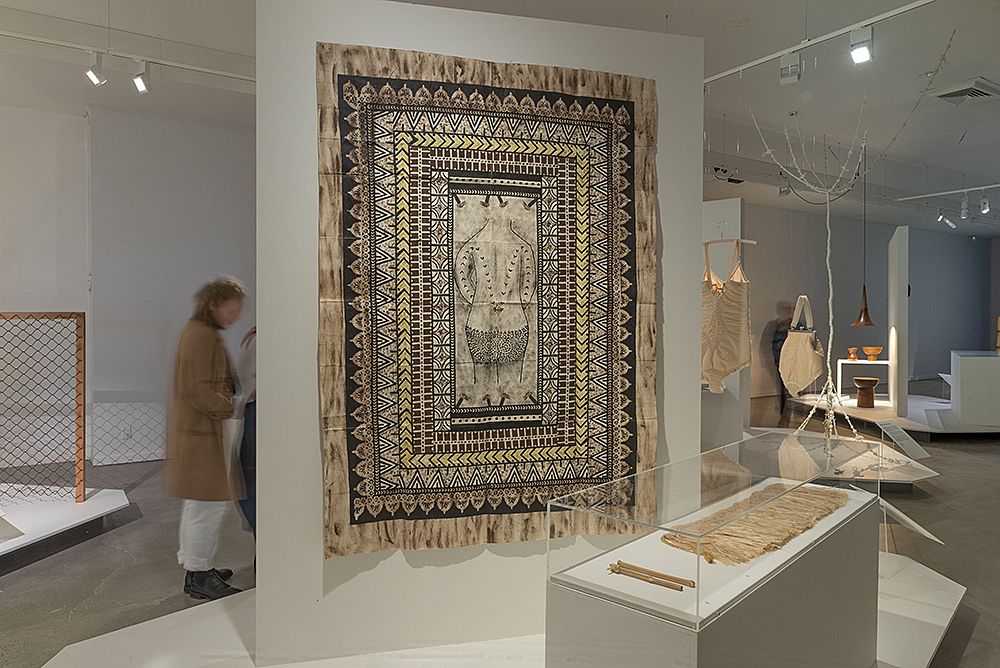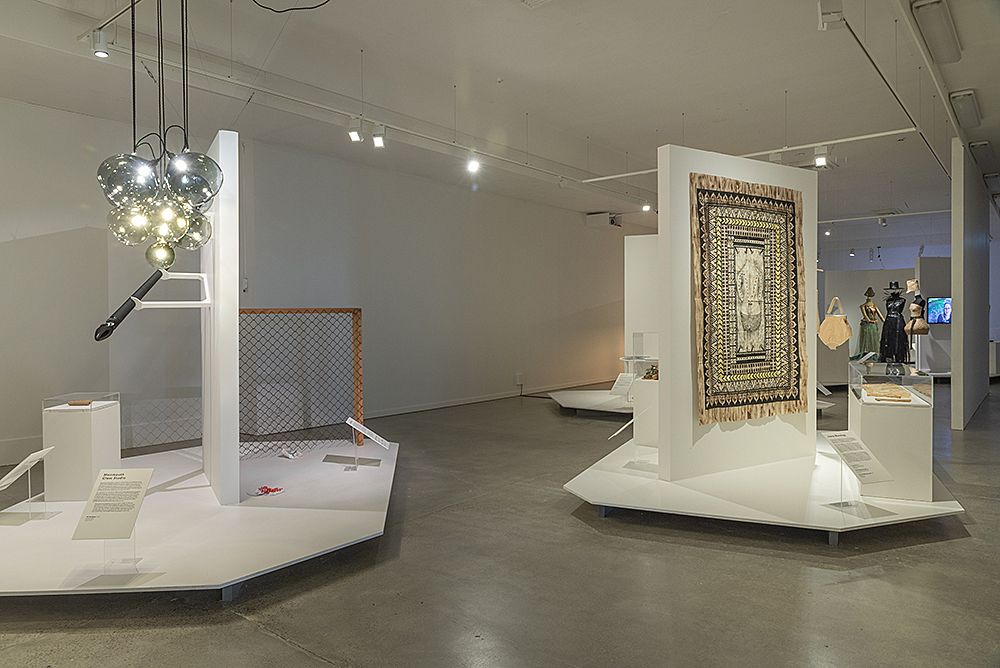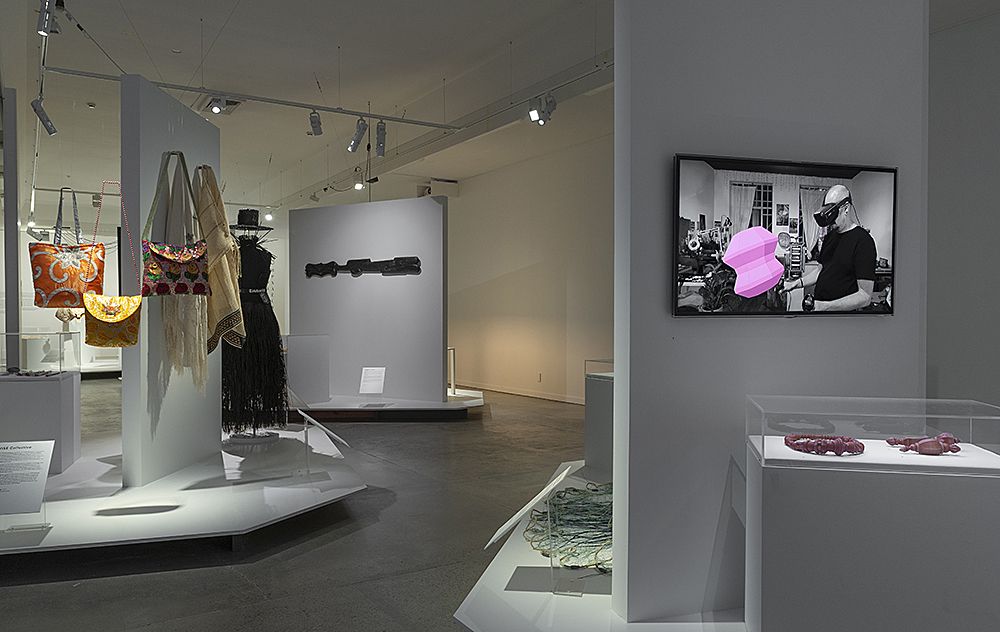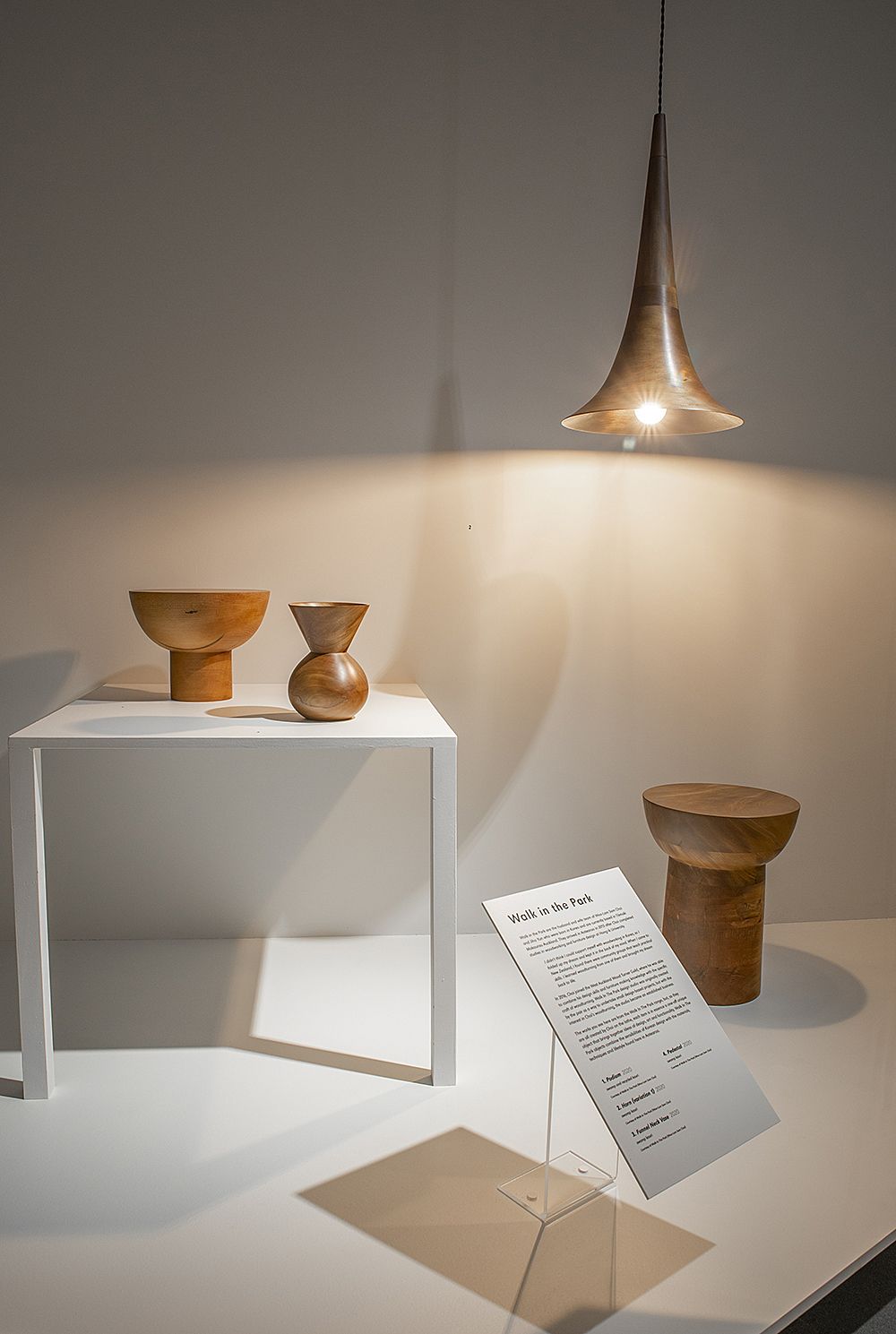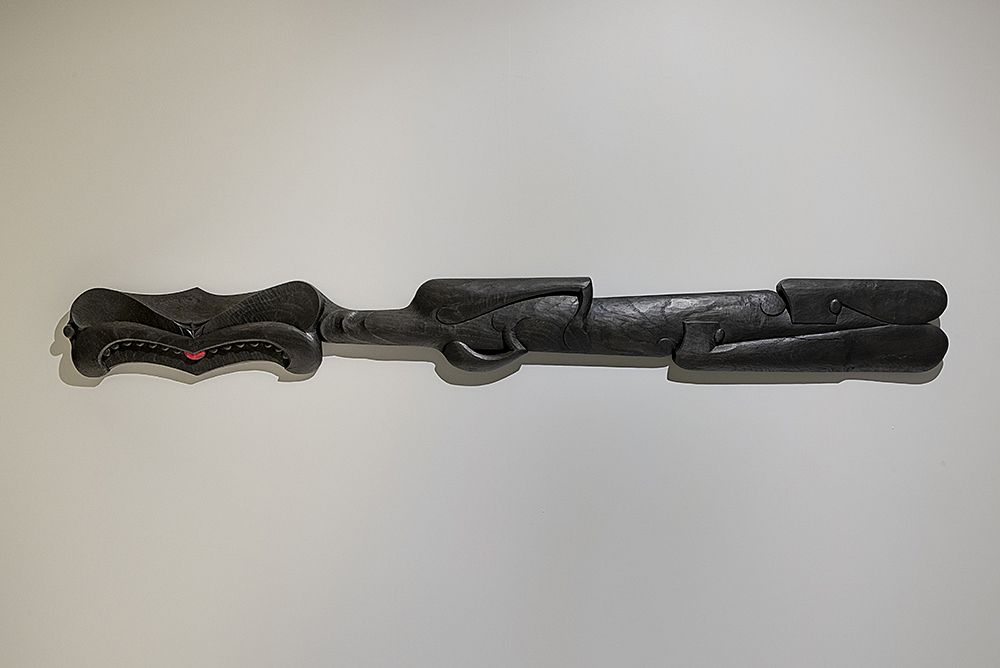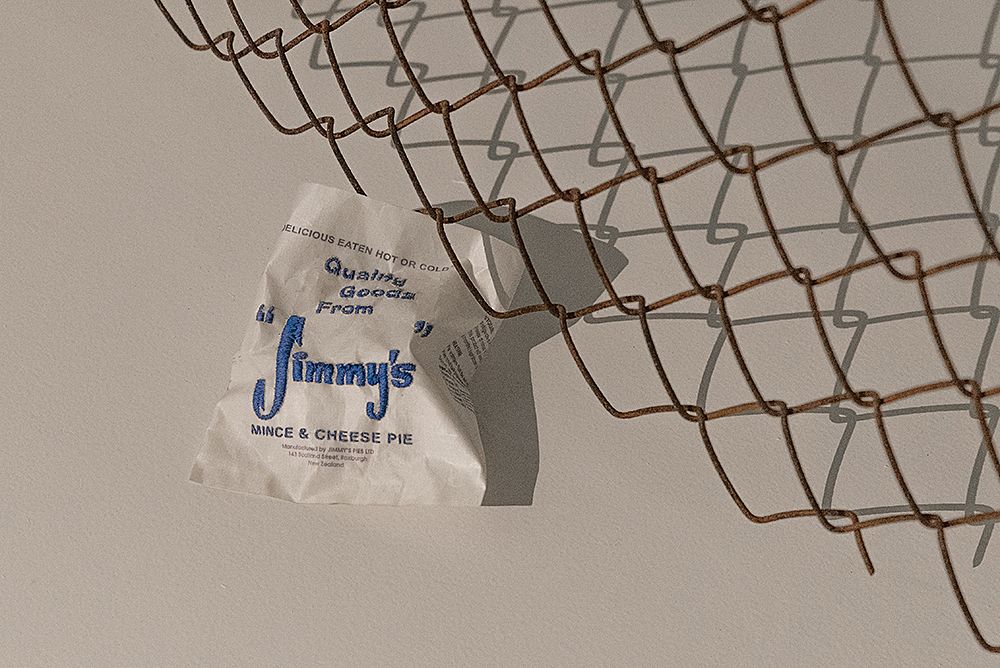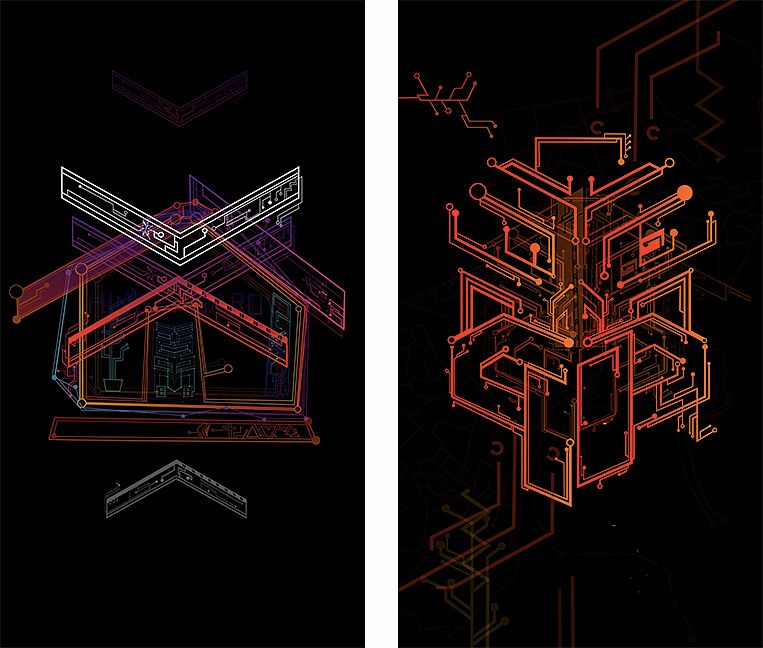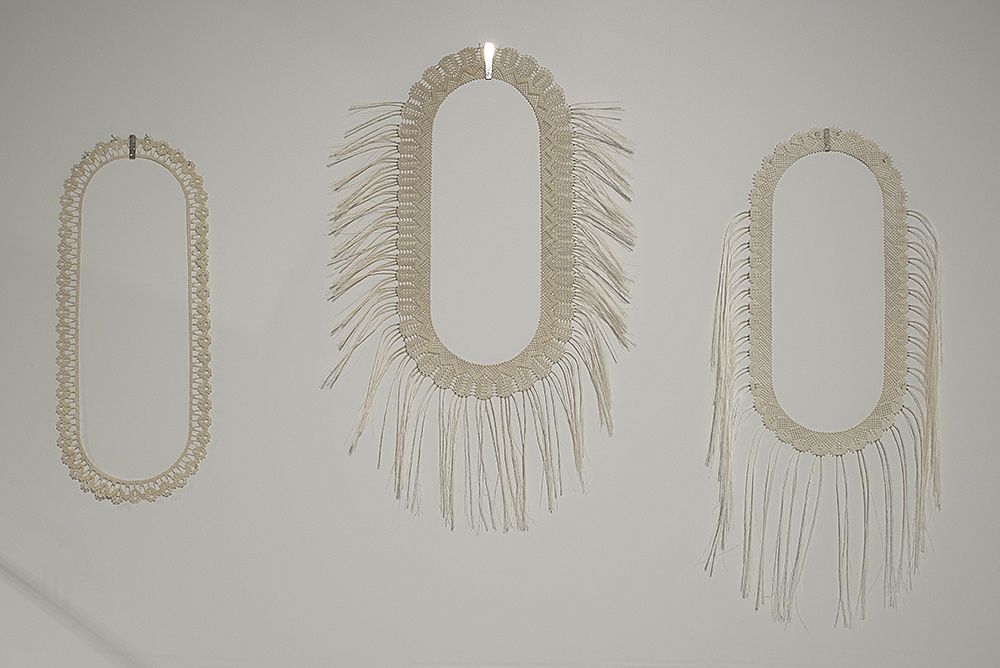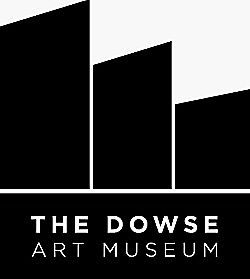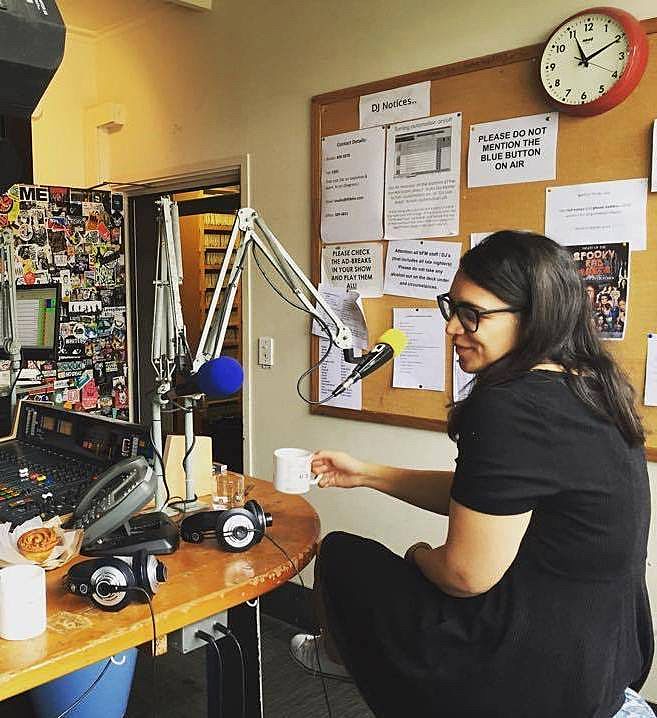Future Histories: A Review of Ā Mua
Ioana Gordon-Smith considers Ā Mua, on now at The Dowse, as the next chapter for Aotearoa craft makers.
Walking into Ā Mua: New Lineages of Making is a surprise. Over the past few years, I’ve become accustomed to craft exhibitions that maximise the amount of space a single work or installation occupies. Often this has been made possible by the focus of recent craft shows on either solo exhibitions or group shows within a single craft discipline. Ā Mua is not like that – on entry the exhibition feels full to the brim. Featuring work by more than 20 artists, the gallery space is set up almost like an archipelago. Floor plinths act as islands that feature three or four different artists’ works, fanning out 360 degrees. The closeness of the works, divided only by free-standing walls or the space between floor plinths, conveys intention to maximise the number of exhibited works.
For some reason, I also expected the show to be solely of Indigenous craft practice. The first two works I saw on walking into the room corrected my assumption immediately. To the right is a series of works by Auckland-based Fijian master artist and knowledge holder Joana Monolagi. On a wall hangs a portrait of a female figure inked into masi. V-shaped marks are shown running from the back. Dense geometric borders amplify the patterns. The masi speaks to the reclamation of veiquia, a tatau art practice specific to Fiji and, moreover, Fijian women. Shown together with this masi portrait are the liku (vau fibre skirt) and nai qia (tatau tools), a reminder that veiqia still operates within ceremonial contexts that precede and follow receiving the marks.
Hanging to the left of Monolagi’s works is a Tilt Pendant series by Monmouth Glass Studio, established by glass artists Stephen Bradbourne and Isaac Katzoff. As the object label notes, the Tilt Pendant acted as ‘proof of concept’ for the commercial viability of a retail glass studio. Monolagi’s and Monmouth’s works could not be more different.
Ā Mua (install view) at The Dowse, 2020. Photo by Shaun Matthews
Ā Mua (install view) at The Dowse, 2020. Photo by Shaun Matthews
Walk in the Park (2020). Ā Mua (install view) at The Dowse, 2020. Photo by Shaun Matthews
Walking around the rest of the exhibition, two things become clear; first, that the works are incredibly disparate, and second, that the label texts are some of the most generous – especially considering the number of works – that I’ve come across in a while. The informative object labels perhaps aren’t so surprising. Ā Mua is curated by Kolokesa Mahina-Tuai and Karl Chitham, two thirds of the editorial team behind the recent publication Crafting Aotearoa: A Cultural History of Making in New Zealand and the Wider Moana Oceania (2019). The book is a tome. In addition to 13 chapters written by the editors, the book includes a whopping 67 guest writers (full disclosure: I am one of them), each contributing short, sidebar essays. Crafting Aotearoa notably pivots away from a siloed history of craft as seen primarily through the lens of studio craft and instead proposes an intersecting and commingling history of Pākehā, Māori and wider Moana histories. The expansive approach necessitates casting a wide net of stories.
Ā Mua is more than closely aligned with the aims of Crafting Aotearoa. According to the press release, the exhibition was originally conceived as the final chapter of the publication. The exhibition continues the book’s argument for a plurality of craft in Aotearoa; the show ranges across many cultures that present here. It’s particularly pleasing to see the inclusion of more recent migrant practices. There’s also a distinct refusal to adhere to a singular purpose for craft practice. Commercial modes of craft making are suggested in the works by Walk In The Park (a husband-and-wife duo creating one-off furniture) and Monmouth Glass Studio. Other works suggest craft practices that are found in social contexts beyond either gallery or retail spaces. Included in Ā Mua is a series of Rumala bags, made by women from the WISE Collective, a community-development project that seeks to support refugee women, with a WISE craft workshop running as part of a wider entrepreneurship programme. The bags, made using Rumala cloth donated by Sikh temple communities, reflect meticulous making, but they also point more widely to the social contexts of migration services, female employment and religious prayer. Similarly, several works point out towards artforms and spaces, such as mōteatea or whāre wānanga, that extend far beyond the exhibition.
Craft, we all know, is perpetually beleaguered by debates that just won’t quit ... a “crisis of classification”
It’s hard to articulate the significance of overtly championing a sprawling selection of practices and approaches. Craft, we all know, is perpetually beleaguered by debates that just won’t quit. Wherever craft appears in galleries, so too does a “crisis of classification” (Crafting Aotearoa, p. 415). Perennial debates on the divisions between craft and art continue to dominate the prefaces to craft books and exhibitions, if not what is included altogether. Recent essays and exhibitions also highlight the way the imposition of this mainly Western distinction on Indigenous practices doubles down on an existing bias that positions Indigenous practices as ‘traditional craft’ in false contradistinction to ‘contemporary art’. Beyond the exhausted divisions between craft and art, though, are further siloes within craft itself. With unspoken biases towards overtly handmade objects that circulate within art-adjacent markets, craft as we know it has often excluded the hobbyist, the designer, the performer.
Ā Mua takes a similar approach to Crafting Aotearoa in unbounding craft from strict taxonomies that have largely prioritised studio-based practices. Augmented reality, 3D-printed works, animations, harakeke armour, glass pendants, sugar work, lace, masi, all sit alongside each other in a broad snapshot of the various threads of craft active in Aotearoa today. Unlike the book, however, there is no ‘chapter’ upon which all the sidebars hang. The closest hint is in the exhibition title. Ā Mua, which is a Māori term used to describe ‘a time to come’, also reflects the cyclic nature of Indigenous time in which the past, present and future intersect, interchange and coexist.
Ā Mua (install view) at The Dowse, 2020. Photo by Shaun Matthews
Eugene Kara, Te Nehenehenui, 2019. Ā Mua (install view) at The Dowse, 2020. Photo by Shaun Matthews
A thread of knowledge transmission permeates throughout Ā Mua. A series of ten toki (hafted adzes), for example, represents a continuation of knowledge passed down from Fuli Fati, a Tokelaun knowledge expert, to his grandsons Kupa Kupa and Jack Kirifi. Like many Indigneous art forms, these toki speak to the doubled-craft of both making the tools and then putting them to use in practising the craft. The label notes that there are four types of toki, each used for a different carving purpose, such as the hulls of a vaka or the detailing in a floor.
Most of the labels contextualise the presented work through either the artist’s past works or the history of the craft they draw upon. Shona Tawhiao’s label notes the artist’s learning under expert weaver Kahutoi Te Kanawa. Similarly, the label for Eugene Kara’s work makes mention of the artist’s training at Toi Ohomai under Lyonel Grant and George Andrews. Tu’ifonulava Kaivelata’s object labels note his introduction to fangufangu (Tongan nose flute), tukipitu (bamboo stomping tubes) and mimiha (bamboo panpipes) by Hufanga Professor ‘Okusitino Mahina. There’s a sense of lineages that exist within a single art practice, too. Jay Hutchinson’s label, for example, notes the genesis of his current interest in a 2006 exhibition that marked a turn in his choice of materials from graffiti to hand embroidery.
Jay Hutchison, An old rusty fence and a jimmy’s mince and cheese pie wrapper (2017). Ā Mua (install view) at The Dowse, 2020. Photo by Shaun Matthews
Kaaterina Kerekere, Takuahiroa (video stills), 2019. Courtesy of the artist
While there’s acknowledgement of history, there isn’t a sense that artists are bound to it. Throughout Ā Mua there feels like a determination to make space for the digital in craft. Crafting Aotearoa notes the persistence of the handmade in the wake of colonisation, industrialisation and late capitalism, yet the digital appears in multiple works in Ā Mua. These include Brendon Monson’s activation of online jewellery via augmented reality, Designworks’ raakau-inspired typeface, used on a website that enables users to construct their own pepeha, and Kaaterina Kerekere’s projected work Takuahiroa (2019). These approaches might seem incongruent with craft, which is often associated with hand making and sustained labour. However, the inclusion of the digital also works to challenge the notion of ‘craft’ as ‘traditional’ practices fixed in particular technologies, rather than modes of material knowledge that evolve. In Designworks’ and Kerekere’s works in particular is the sense of the digital being used to reclaim and reinsert centuries-old Indigenous knowledges into everyday circulation.
The work of Kereama Taepa, for example, considers the ways in which digital technology and 3D printing might relate to whakairo. Four taonga pūoro are exhibited that have been made with open-source 3D software, using bio plastics. Taepa has in previous exhibitions made use of a new term – whakapī – to note the distinction between the methods of whakairo rākau and digital printing. While whakairo works through the carving out of material to reveal form, digital printing technology works in an additive mode, laying material to create form. The word whakapī – ‘to make like a bee’ – riffs off the word whakairo, which describes the removal of rākau as similar to the iro (maggot) eating away at matter.
Kereama Taepa, He Pukaea, 2019. Ā Mua at The Dowse (install view). Photo: Shaun Matthews
Rowan Panther, Lei #1, #3, #2 (2017-18). Ā Mua (install view) at The Dowse, 2020. Photo by Shaun Matthews
Each of the individual works in Ā Mua then represents a dense intersection between history and innovation; a summary of each would be beyond the scope of this review. The exhibition oscillates between the need to acknowledge the coexistence of multiple modes of making, and the specificity of the histories each practice draws on respectively. Given the deliberately expansive scope of the exhibition and its refusal of singularity, coupled with the extensive histories within each of the individual works, it would have been great to see the exhibition occupy more gallery space, so that each installation might have more of a moment. Some artworks suffered from the even installation treatment. Rowan Panther’s phenomenally intricate muka lace works would have been better served on a dark, rather than white, wall. Similarly, Kaaterina Kerekere’s projected work Takuahiroa (2019) washes out a bit in the even lighting. The most successful displays are those that come off the wall or plinth, asserting their three-dimensionality. Victoria McIntosh’s found materials – underwear, purses, pearls – that recall historically female domestic crafts as well as gendered expectations of attire or appearance, transform into soft sculptures that evoke more provocatively the female body.
Nevertheless, it feels like there’s a deliberately egalitarian design strategy at play. In response to art critic Lana Lopesi’s question – “How can we work towards this multi-modal craft future?” – Kolokesa Māhina-Tuai notes:
We need to create spaces in which we can highlight what’s happening and say, hey here’s the richness of Aotearoa. Otherwise it’s going to be the same conversations, the same terminologies.
Ā Mua very much feels like a show that attempts to open out these questions by setting aside questions of binaries and fixed boundaries of craft as irrelevant, and considering all of craft’s wealth and diversity. Eschewing craft boundaries, it is instead a fluidity across geographies and culture, grounded in belonging to Aotearoa, that Ā Mua suggests is the future of craft.
Consistently, the cross-cultural works reflect a need to both work sustainably and to understand a self-aware relationship to Aotearoa, and to tangata whenua more specifically. Wai Ching Chan’s work uses Chinese knots as a means of bonded connection. The three knots used – the button knot, the caisson knot and the endless knot – are used here symbolically to consider the relationship the artist holds to both her own heritage and to tangata whenua as a tauiwi. Similarly, Jo Torr, an artist known for her interest in exploring early intercultural contact through historical dress, presents two works that imaginatively speculate on the relationship between the rangatira Tītere and a young woman who witnessed his haka in 19th-century England. Hybrid cultural references occur again and again. Rowan Panther, of European and Sāmoan heritage, combines the European bobbin-lace methods with muka and its strong connections to Aotearoa, and the lei form inspired by time spent with her grandfather in Rarotonga.
These works give rise to the question of whether the future of craft in Aotearoa might be more than the placement of Māori, Pākehā, Moana Oceania and Asian knowledge and practices next to one another. Is the future of craft one in which its various threads don’t simply coexist, but rather intermingle? If we want a future of craft where new conversations and connections might emerge, craft’s diversity must be its foundational history.
Ā Mua: New Lineages of Making is on show at The Dowse from 6 June – 11 October 2020
Dowse
This piece is presented as part of a partnership with The Dowse Art Museum, which covers the costs of paying our writers while we retain all editorial control.
Feature image (top of page): Joanna Monolagi, Awakening, 2017. Ā Mua (install view) at The Dowse, 2020. Photo by Shaun Matthews.
All images courtesy of the artists and The Dowse Art Museum.
